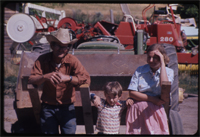WILLOW FALLS RANCH, 1975
SETTING
In 1974, my maternal grandparents, Donald and Ruth Huddleston, purchased a small ranch just outside of Payette, Idaho. The Willow Falls Ranch, as it is known, sits several miles away from, well, anything. During the first half of 1975, my parents, Myron and Debra Whitehead, spent several months living on the ranch with my grandparents while Mr. Whitehead, my father, interned with Dr. Daniels in Ontario, Oregon. Mr. and Mrs. Whitehead took numerous pictures of the new ranch and the extended family.

MATERIALS
The collection consists of 59 images, all taken in 1975 between the months of January to July. These pictures were taken on a consumer-grade Canon camera and developed into 35mm slides. Myron Whitehead was the primary photographer. The content of the slides varies, but there are several prevalent themes: family members, the landscape, the new ranch and its equipment, and an eclipse that occurred in May.
The slides were not the only documentation of the new ranch, however. Mr. and Mrs. Huddleston decided to keep a journal of their experiences with the ranch. They recorded events relevant to farming, such as what tools were needed or purchased, when they planted crops and when the first frosts of Fall came. These entries were aimed at improving the productivity of the farm over the long term. Along with these journal entries, documentation relevant to Mr. Whitehead’s internship will be presented with the slides.
AUDIENCE

The digitization of this collection is valuable for family, for whom the people and places are most significant. Personally, the collection is interesting as it will allow me to see my parents almost a decade before I was born (and about as old as I am now). Also, the collection will illustrate the ranch twenty years before I can remember it.
Other researchers may also glean items of interest from among the collection. For instance, the slides with people as the subject show examples of the clothing and hair styles of the mid 1970s. The collection has the advantage of containing subjects from a wide age range. Local historians or rural development researchers may be able to use the photographs to see the status of development around Payette in 1975. Several pictures contain tools and machines used in family farming, and may be useful for a researcher studying the use of technology.
VALUE OF DIGITIZATION

The goal for this project is to take advantage of the two main facets of digitization: accessibility and preservation. Prior to the start of this project, the slides were places in large boxes in a single location in Mr. and Mrs. Whitehead’s home. By tagging the images and adding metadata to the images they will be more easily filterable. By creating a digital access portal for these images, not only can dispersed family members or other interested individuals view the materials, but also the danger of loss of the materials due to natural disaster (in particular, from wildfires) is reduced.




